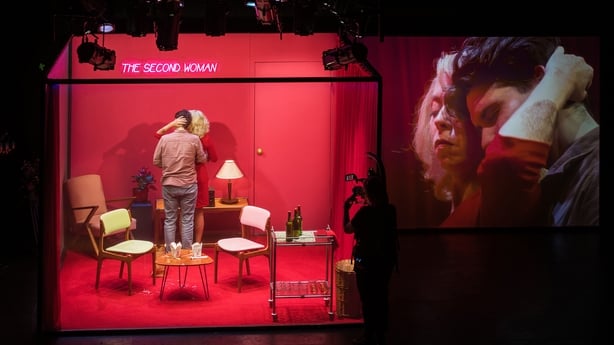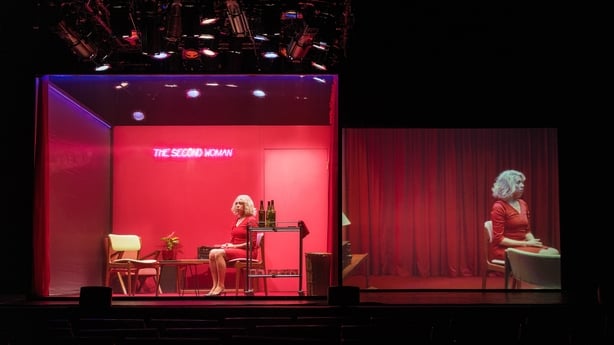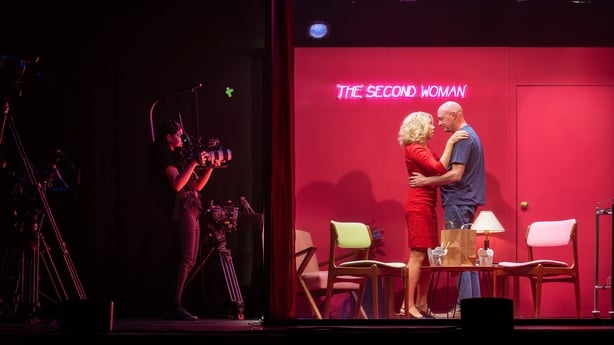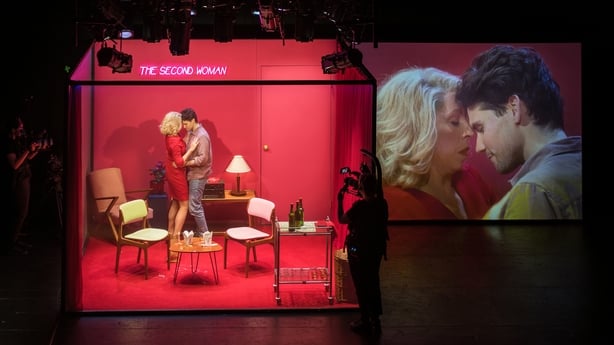Auto-playing algorithm-driven YouTube videos prepped us for this. Next-episode streaming services primed us for it. Just fifteen more minutes on social media again and again too late at night trained us for it. We were made for this. Audiences, crew and one hundred acting collaborators were made for this. But more than anything actor Eileen Walsh was made for this. Between 4pm on Saturday 14 June and 4pm on Sunday 15 June, Walsh spent 24 hours playing The Second Woman at Cork Opera House as part of Cork Midsummer Festival 2025. I watched her for sixteen of them.
An endlessly thrilling vehicle for Walsh's impeccable timing, wit, empathy, and intelligence, The Second Woman bills itself as "a scene between a man and a woman in a relationship that has lost its creativity and romance". Created and directed by Sydney-based Nat Randall and Anna Breckon, and inspired by classics of melodrama, it’s a play that can’t be neatly contained in a one-line description, because in unfolding it becomes uniquely itself. For a start, romance might not always mean romantic, and not all of the men are men. In bouts of about ten minutes, one hundred Marty’s play against Walsh’s Virginia, once each. A majority are "non-actors" and none have rehearsed with her. Never have more noodles been flung or more awkward dancing done in twenty four hours in the name of art. Never have we seen Walsh quite like this. It makes for utterly addictive viewing.

The play is about taking and/or giving love and power away. It addresses over and over questions of need, want, dependency, identity, control, gender and consent, and the spoken and unspoken dynamics of dominance between two people that can be inherent in all of that. Walsh is a woman trapped in a room like a hotel room, a waiting room, a bordello, an apartment, a secret love nest, a therapy space. Concurrent footage is live-mixed from three fixed and two hand-held simultaneously filming cameras onto an on-stage screen next to the cube in which the action takes place, over and over and over again…
With only about twenty lines of fixed script, most of them short questions, The Second Woman has a Tardis-like ability to take the story anywhere, depending on what the other actor says and how Walsh reacts. At this she is an indefatigable genius: echoing, mimicking, responding to and sometimes usurping the verbal and physical cues of each new partner, with improvised remarks, body language and facial response. At times, her face, body parts, and those of her partner loom large on the screen next to the live action, the camera magnifying the implications of each move.
Finally something to binge on that is actually good for your brain, heart and soul.
To say it is addictive viewing is to underplay just how fast time few and how compelling this endurance test becomes, so much so it immediately ceases to become one. Pretty fast, we are all in this willingly together. Possibly even more significant, was the feeling that if you stopped looking for a minute you were going to miss something good. Audiences arrived and stayed, some slept briefly in the seats. Cheaper than a hotel room, was a quip heard in the foyer. Also overheard at the Opera House: She’s got a great pair of pins (she does); That last one was brilliant (correct); It’s Jock from The Young Offenders! (it was); That was hilarious (seats still shaking with laughter); Oh my god (everyone shocked to silence); Aww… (multiple times, eyes welling); and, I think that’s her real husband (and it was one of the most moving scenes with a non-professional actor, many of whom were exquisitely good). Walsh didn’t know who her collaborators would be, or in what order they would arrive. One was so stage struck he forgot every one of his lines; she carried on, and carried him, and made it bizarrely wonderful.
Part of the conceit is that the audience becomes complicit in the inadvertent, unexpected and pre-conceived in-jokes the interactions produce: How are you? she asks. Tired, says one, and Walsh gives a yeah-tell-me-about-it shrug, as the whole audience guffaws, twenty hours in. This feels like déjà vu, says another. Em, yep, says Walsh’s face, and we are there with her, acknowledging the repeat shape of the thing, and loving it. I know how hungry you get when you act like this, says one as he walks in, and the whole theatre, presumably including Walsh, wonders just how many more boxes of plain rice noodles in twenty-four hours this woman can stomach.

With a five-ish minute window for viewers to arrive, leave, move seats, check phones or chat every ten minutes or so as Walsh cleared noodles from chairs and floor, and a fifteen-ish minute break every two hours for the performer, before each set like clockwork Walsh appeared in her tight red dress and rolled her drinks trolley containing three full whiskey bottles and eight pairs of low glasses through the pink door into the terrarium-like spotlit room.
Offering a different audience experience depending on where you sit, the set has visual echoes of Twin Peaks (red curtain, languid mood, a feeling that something uncannily epic is occurring), The Cube (repeat action with some rules and a new contestant every fifteen minutes television gameshow vibes), and a Severance wellness session (Virginia returns each time to a neatly dressed, wiped clean version of herself in a sparse but purposefully furnished room before the task begins again, anew).

The Second Woman will carry on whether anyone is watching or not, but the presence of the audience and their response is part of the show. A sign outside asked for no clapping between scenes, but you can’t tell an enthralled and appreciative Irish audience not to clap, especially a Cork audience when this much-respected and much-loved actress is back on home turf and acting up an unmissable storm. She makes her kitten-heel stumble look new every time she does it. She dances 100 times with 100 different partners and every time the dance tells a different tale. She makes the lines new every time she says them. Her curiosity and presence is a reminder that there are 100+ ways any human conversation, no matter how pre-planned, can go. It’s a play about the endless tragedy and concurrent absurdity of life, and the enduring power of surprise. It subverts familiar tropes of Happy Ever After and even The End. There is no end. Walsh rewinds the cassette tape on which her dancing music plays, the tape returns to start and the scene begins again, the main player not only seeking a different outcome each time, but getting one.

This immersion in a fictional world filled with human truths temporarily switches off the real world outside, and we are reminded again and again that humans are messy and lovable and mean. They are awful and awkward, beautiful, broken and brilliant. Finally something to binge on that is actually good for your brain, heart and soul. Kudos to the technical team that pulled it off, but always at the heart of it was Walsh, mesmerising, compelling, endlessly watchable, funny, silly, tragic, in-control, lost. What a part. What an actor. What a gift.

